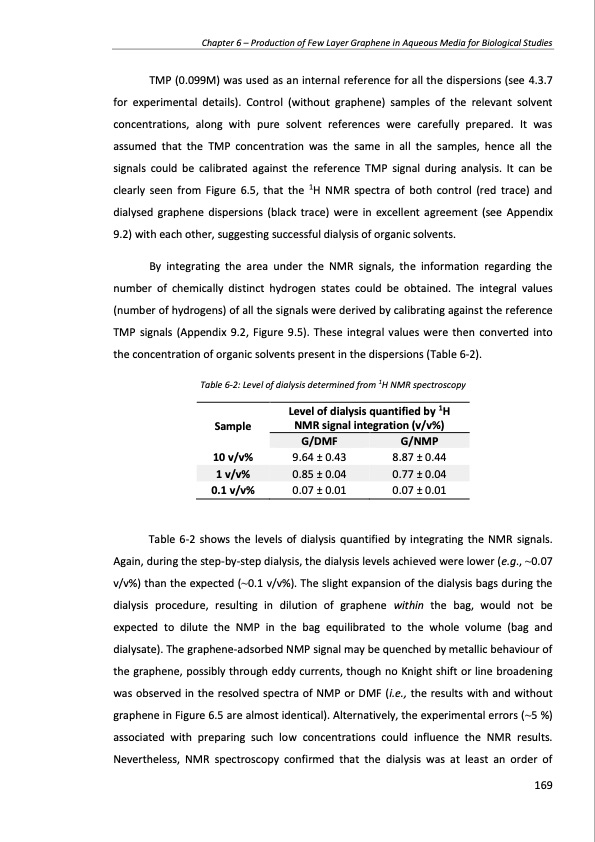
PDF Publication Title:
Text from PDF Page: 169
Chapter 6 – Production of Few Layer Graphene in Aqueous Media for Biological Studies TMP (0.099M) was used as an internal reference for all the dispersions (see 4.3.7 for experimental details). Control (without graphene) samples of the relevant solvent concentrations, along with pure solvent references were carefully prepared. It was assumed that the TMP concentration was the same in all the samples, hence all the signals could be calibrated against the reference TMP signal during analysis. It can be clearly seen from Figure 6.5, that the 1H NMR spectra of both control (red trace) and dialysed graphene dispersions (black trace) were in excellent agreement (see Appendix 9.2) with each other, suggesting successful dialysis of organic solvents. By integrating the area under the NMR signals, the information regarding the number of chemically distinct hydrogen states could be obtained. The integral values (number of hydrogens) of all the signals were derived by calibrating against the reference TMP signals (Appendix 9.2, Figure 9.5). These integral values were then converted into the concentration of organic solvents present in the dispersions (Table 6-2). Table 6-2: Level of dialysis determined from 1H NMR spectroscopy Sample 10 v/v% 1 v/v% 0.1 v/v% Level of dialysis quantified by 1H NMR signal integration (v/v%) G/DMF 9.64 ± 0.43 0.85 ± 0.04 0.07 ± 0.01 G/NMP 8.87 ± 0.44 0.77 ± 0.04 0.07 ± 0.01 Table 6-2 shows the levels of dialysis quantified by integrating the NMR signals. Again, during the step-by-step dialysis, the dialysis levels achieved were lower (e.g., ~0.07 v/v%) than the expected (~0.1 v/v%). The slight expansion of the dialysis bags during the dialysis procedure, resulting in dilution of graphene within the bag, would not be expected to dilute the NMP in the bag equilibrated to the whole volume (bag and dialysate). The graphene-adsorbed NMP signal may be quenched by metallic behaviour of the graphene, possibly through eddy currents, though no Knight shift or line broadening was observed in the resolved spectra of NMP or DMF (i.e., the results with and without graphene in Figure 6.5 are almost identical). Alternatively, the experimental errors (~5 %) associated with preparing such low concentrations could influence the NMR results. Nevertheless, NMR spectroscopy confirmed that the dialysis was at least an order of 169PDF Image | PRODUCTION AND APPLICATIONS OF GRAPHENE AND ITS COMPOSITES

PDF Search Title:
PRODUCTION AND APPLICATIONS OF GRAPHENE AND ITS COMPOSITESOriginal File Name Searched:
graphene-production-applications.PDFDIY PDF Search: Google It | Yahoo | Bing
Salgenx Redox Flow Battery Technology: Power up your energy storage game with Salgenx Salt Water Battery. With its advanced technology, the flow battery provides reliable, scalable, and sustainable energy storage for utility-scale projects. Upgrade to a Salgenx flow battery today and take control of your energy future.
| CONTACT TEL: 608-238-6001 Email: greg@infinityturbine.com | RSS | AMP |